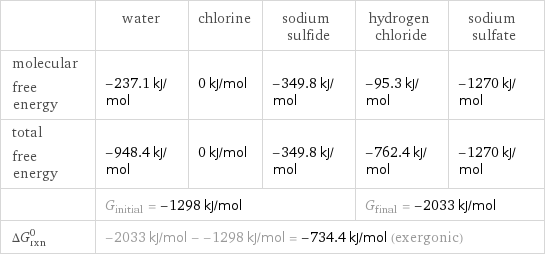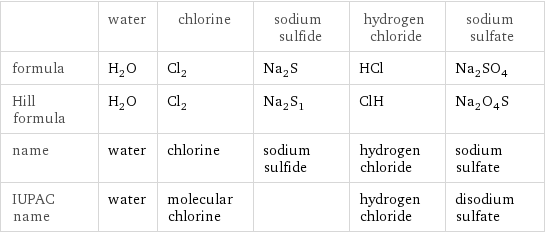Input interpretation

H_2O water + Cl_2 chlorine + Na_2S sodium sulfide ⟶ HCl hydrogen chloride + Na_2SO_4 sodium sulfate
Balanced equation

Balance the chemical equation algebraically: H_2O + Cl_2 + Na_2S ⟶ HCl + Na_2SO_4 Add stoichiometric coefficients, c_i, to the reactants and products: c_1 H_2O + c_2 Cl_2 + c_3 Na_2S ⟶ c_4 HCl + c_5 Na_2SO_4 Set the number of atoms in the reactants equal to the number of atoms in the products for H, O, Cl, Na and S: H: | 2 c_1 = c_4 O: | c_1 = 4 c_5 Cl: | 2 c_2 = c_4 Na: | 2 c_3 = 2 c_5 S: | c_3 = c_5 Since the coefficients are relative quantities and underdetermined, choose a coefficient to set arbitrarily. To keep the coefficients small, the arbitrary value is ordinarily one. For instance, set c_3 = 1 and solve the system of equations for the remaining coefficients: c_1 = 4 c_2 = 4 c_3 = 1 c_4 = 8 c_5 = 1 Substitute the coefficients into the chemical reaction to obtain the balanced equation: Answer: | | 4 H_2O + 4 Cl_2 + Na_2S ⟶ 8 HCl + Na_2SO_4
Structures

+ + ⟶ +
Names

water + chlorine + sodium sulfide ⟶ hydrogen chloride + sodium sulfate
Reaction thermodynamics
Enthalpy

| water | chlorine | sodium sulfide | hydrogen chloride | sodium sulfate molecular enthalpy | -285.8 kJ/mol | 0 kJ/mol | -364.8 kJ/mol | -92.3 kJ/mol | -1387 kJ/mol total enthalpy | -1143 kJ/mol | 0 kJ/mol | -364.8 kJ/mol | -738.4 kJ/mol | -1387 kJ/mol | H_initial = -1508 kJ/mol | | | H_final = -2126 kJ/mol | ΔH_rxn^0 | -2126 kJ/mol - -1508 kJ/mol = -617.4 kJ/mol (exothermic) | | | |
Gibbs free energy

| water | chlorine | sodium sulfide | hydrogen chloride | sodium sulfate molecular free energy | -237.1 kJ/mol | 0 kJ/mol | -349.8 kJ/mol | -95.3 kJ/mol | -1270 kJ/mol total free energy | -948.4 kJ/mol | 0 kJ/mol | -349.8 kJ/mol | -762.4 kJ/mol | -1270 kJ/mol | G_initial = -1298 kJ/mol | | | G_final = -2033 kJ/mol | ΔG_rxn^0 | -2033 kJ/mol - -1298 kJ/mol = -734.4 kJ/mol (exergonic) | | | |
Equilibrium constant
![Construct the equilibrium constant, K, expression for: H_2O + Cl_2 + Na_2S ⟶ HCl + Na_2SO_4 Plan: • Balance the chemical equation. • Determine the stoichiometric numbers. • Assemble the activity expression for each chemical species. • Use the activity expressions to build the equilibrium constant expression. Write the balanced chemical equation: 4 H_2O + 4 Cl_2 + Na_2S ⟶ 8 HCl + Na_2SO_4 Assign stoichiometric numbers, ν_i, using the stoichiometric coefficients, c_i, from the balanced chemical equation in the following manner: ν_i = -c_i for reactants and ν_i = c_i for products: chemical species | c_i | ν_i H_2O | 4 | -4 Cl_2 | 4 | -4 Na_2S | 1 | -1 HCl | 8 | 8 Na_2SO_4 | 1 | 1 Assemble the activity expressions accounting for the state of matter and ν_i: chemical species | c_i | ν_i | activity expression H_2O | 4 | -4 | ([H2O])^(-4) Cl_2 | 4 | -4 | ([Cl2])^(-4) Na_2S | 1 | -1 | ([Na2S])^(-1) HCl | 8 | 8 | ([HCl])^8 Na_2SO_4 | 1 | 1 | [Na2SO4] The equilibrium constant symbol in the concentration basis is: K_c Mulitply the activity expressions to arrive at the K_c expression: Answer: | | K_c = ([H2O])^(-4) ([Cl2])^(-4) ([Na2S])^(-1) ([HCl])^8 [Na2SO4] = (([HCl])^8 [Na2SO4])/(([H2O])^4 ([Cl2])^4 [Na2S])](../image_source/5bc11cd13efe94f0de22a439111b5e25.png)
Construct the equilibrium constant, K, expression for: H_2O + Cl_2 + Na_2S ⟶ HCl + Na_2SO_4 Plan: • Balance the chemical equation. • Determine the stoichiometric numbers. • Assemble the activity expression for each chemical species. • Use the activity expressions to build the equilibrium constant expression. Write the balanced chemical equation: 4 H_2O + 4 Cl_2 + Na_2S ⟶ 8 HCl + Na_2SO_4 Assign stoichiometric numbers, ν_i, using the stoichiometric coefficients, c_i, from the balanced chemical equation in the following manner: ν_i = -c_i for reactants and ν_i = c_i for products: chemical species | c_i | ν_i H_2O | 4 | -4 Cl_2 | 4 | -4 Na_2S | 1 | -1 HCl | 8 | 8 Na_2SO_4 | 1 | 1 Assemble the activity expressions accounting for the state of matter and ν_i: chemical species | c_i | ν_i | activity expression H_2O | 4 | -4 | ([H2O])^(-4) Cl_2 | 4 | -4 | ([Cl2])^(-4) Na_2S | 1 | -1 | ([Na2S])^(-1) HCl | 8 | 8 | ([HCl])^8 Na_2SO_4 | 1 | 1 | [Na2SO4] The equilibrium constant symbol in the concentration basis is: K_c Mulitply the activity expressions to arrive at the K_c expression: Answer: | | K_c = ([H2O])^(-4) ([Cl2])^(-4) ([Na2S])^(-1) ([HCl])^8 [Na2SO4] = (([HCl])^8 [Na2SO4])/(([H2O])^4 ([Cl2])^4 [Na2S])
Rate of reaction
![Construct the rate of reaction expression for: H_2O + Cl_2 + Na_2S ⟶ HCl + Na_2SO_4 Plan: • Balance the chemical equation. • Determine the stoichiometric numbers. • Assemble the rate term for each chemical species. • Write the rate of reaction expression. Write the balanced chemical equation: 4 H_2O + 4 Cl_2 + Na_2S ⟶ 8 HCl + Na_2SO_4 Assign stoichiometric numbers, ν_i, using the stoichiometric coefficients, c_i, from the balanced chemical equation in the following manner: ν_i = -c_i for reactants and ν_i = c_i for products: chemical species | c_i | ν_i H_2O | 4 | -4 Cl_2 | 4 | -4 Na_2S | 1 | -1 HCl | 8 | 8 Na_2SO_4 | 1 | 1 The rate term for each chemical species, B_i, is 1/ν_i(Δ[B_i])/(Δt) where [B_i] is the amount concentration and t is time: chemical species | c_i | ν_i | rate term H_2O | 4 | -4 | -1/4 (Δ[H2O])/(Δt) Cl_2 | 4 | -4 | -1/4 (Δ[Cl2])/(Δt) Na_2S | 1 | -1 | -(Δ[Na2S])/(Δt) HCl | 8 | 8 | 1/8 (Δ[HCl])/(Δt) Na_2SO_4 | 1 | 1 | (Δ[Na2SO4])/(Δt) (for infinitesimal rate of change, replace Δ with d) Set the rate terms equal to each other to arrive at the rate expression: Answer: | | rate = -1/4 (Δ[H2O])/(Δt) = -1/4 (Δ[Cl2])/(Δt) = -(Δ[Na2S])/(Δt) = 1/8 (Δ[HCl])/(Δt) = (Δ[Na2SO4])/(Δt) (assuming constant volume and no accumulation of intermediates or side products)](../image_source/3d9c0c4b80df86bc5968abe61255fe5c.png)
Construct the rate of reaction expression for: H_2O + Cl_2 + Na_2S ⟶ HCl + Na_2SO_4 Plan: • Balance the chemical equation. • Determine the stoichiometric numbers. • Assemble the rate term for each chemical species. • Write the rate of reaction expression. Write the balanced chemical equation: 4 H_2O + 4 Cl_2 + Na_2S ⟶ 8 HCl + Na_2SO_4 Assign stoichiometric numbers, ν_i, using the stoichiometric coefficients, c_i, from the balanced chemical equation in the following manner: ν_i = -c_i for reactants and ν_i = c_i for products: chemical species | c_i | ν_i H_2O | 4 | -4 Cl_2 | 4 | -4 Na_2S | 1 | -1 HCl | 8 | 8 Na_2SO_4 | 1 | 1 The rate term for each chemical species, B_i, is 1/ν_i(Δ[B_i])/(Δt) where [B_i] is the amount concentration and t is time: chemical species | c_i | ν_i | rate term H_2O | 4 | -4 | -1/4 (Δ[H2O])/(Δt) Cl_2 | 4 | -4 | -1/4 (Δ[Cl2])/(Δt) Na_2S | 1 | -1 | -(Δ[Na2S])/(Δt) HCl | 8 | 8 | 1/8 (Δ[HCl])/(Δt) Na_2SO_4 | 1 | 1 | (Δ[Na2SO4])/(Δt) (for infinitesimal rate of change, replace Δ with d) Set the rate terms equal to each other to arrive at the rate expression: Answer: | | rate = -1/4 (Δ[H2O])/(Δt) = -1/4 (Δ[Cl2])/(Δt) = -(Δ[Na2S])/(Δt) = 1/8 (Δ[HCl])/(Δt) = (Δ[Na2SO4])/(Δt) (assuming constant volume and no accumulation of intermediates or side products)
Chemical names and formulas

| water | chlorine | sodium sulfide | hydrogen chloride | sodium sulfate formula | H_2O | Cl_2 | Na_2S | HCl | Na_2SO_4 Hill formula | H_2O | Cl_2 | Na_2S_1 | ClH | Na_2O_4S name | water | chlorine | sodium sulfide | hydrogen chloride | sodium sulfate IUPAC name | water | molecular chlorine | | hydrogen chloride | disodium sulfate